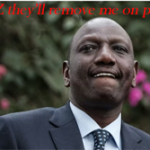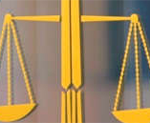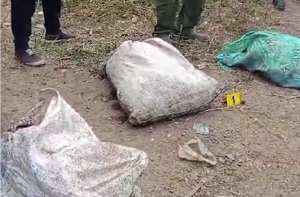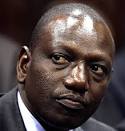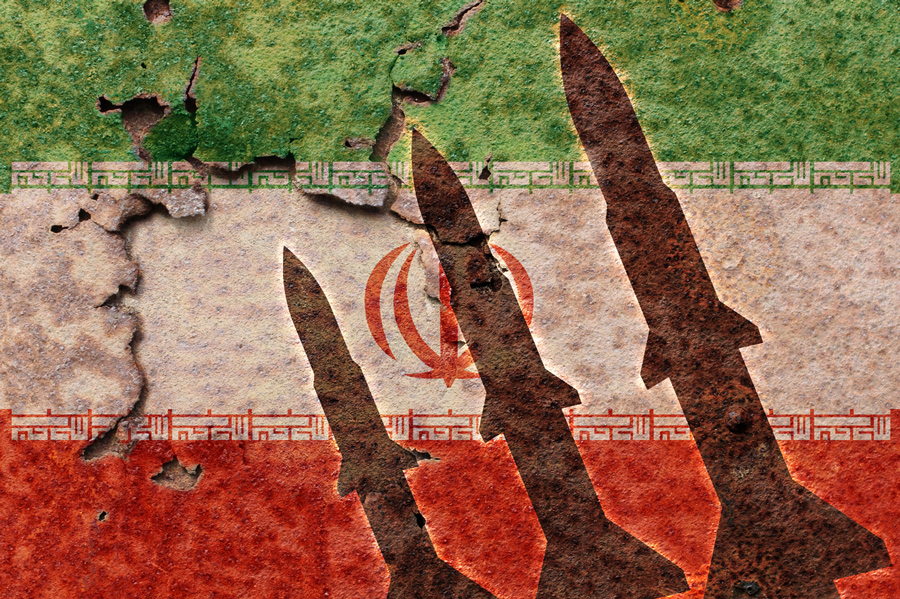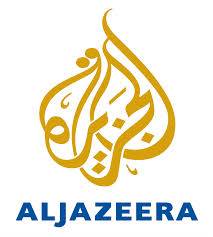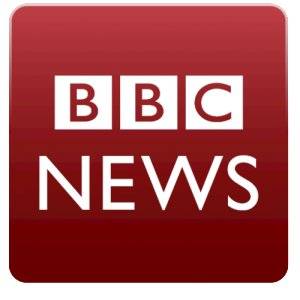Palestinian schoolchildren who returned to their schools last week are being taught that women are witches and Tel Aviv is an Arab city. They are also being exposed to maps that ignore Israel’s existence.
Despite all Palestinian Authority (PA) claims to the contrary, then, the new textbooks hardly promote peace and coexistence between Palestinians and Israel.
A new school curriculum published by the PA last week has drawn sharp criticism from many Palestinians, who say the textbooks demonize women and contain “factual and historical” errors.
The controversial version of the curriculum for grades 1-4 was launched by PA Prime Minister Rami Hamdallah during a ceremony in Ramallah, on the eve of beginning of the new school year.
Within hours, Palestinians, particularly female activists, voiced resentment over the new curriculum and called on the PA leadership to remove it immediately. Some Palestinians denounced the curriculum, which was drafted by a team of Palestinian educational experts, as a “scandal” and a “distortion of facts.” They said that a curriculum full of errors and “distortions of facts” was a guaranteed recipe for raising a new generation of illiterate and misinformed Palestinians.
PA officials, arguing that the new curriculum was an experimental one and is open for amendments and development, have promised to make corrections in the textbooks.
So what exactly is it that enraged the critics about the new textbooks, prompting such sarcasm concerning the education process in Palestinian schools?
A map in one of the textbooks refers to the West Bank city of Ramallah as the “center of Palestine,” while Jerusalem is referred to as a city that is located south of Ramallah.
Critics argue that this terminology turns Ramallah, the headquarters of the Palestinian Authority leadership and government, into the de facto capital of the Palestinians. This, they add, undermines the Palestinian claim to Jerusalem as the capital of a future Palestinian state. “Why has Jerusalem been marginalized in the new textbooks?” critics asked. “This is indeed disgraceful!”
Another error in the textbooks relocates the interior West Bank city of Bethlehem to the coast of the Gaza Strip. “Bethlehem now has its own beach,” was one of many sarcastic remarks made by furious Palestinians who took to social media to condemn the new curriculum. A Palestinian from Hebron commented: “The residents of Hebron are also demanding that our Ministry of Education give us a beach like the one they gave Bethlehem.”
The new textbooks are also being criticized for referring to Tel Aviv in a map of “Palestine” that does not mention Israel. The map refers to Tel Aviv by its Arabic name, Tal Al-Rabi’a. Critics argue that it is a mistake to refer to Tel Aviv by its Arabic name because this is an Israeli city that was established “on the ruins of Arab villages.” They claim that Tel Aviv is a modern name that “is not linked to the history of Palestine.” The map of “Palestine” in the textbooks extends from the city of Safed in the north to Rafah in the southern Gaza Strip.
But all this is nothing compared to the demonization of women, who are depicted in first- and second-grade Islamic Education textbooks as witches and sorceresses — and this is really catching flak.
One image features a witch under the Quran verse that reads: “I seek refuge with Allah from Satan, the accursed.” Another image of a witch is accompanied by a verse from the Quran that refers to the “evil of malignant witchcraft.”
Critics say that associating women with witchcraft is extremely disrespectful and offensive towards Palestinian women.
“Children in grades 1 and 2 are being taught that women are witches or hags,” they protested. “The lesson they are being taught is that the first half of society is Muslim, while the second half is infidel.”
Palestinian female activists expressed outrage over the depiction of women as witches and sorceresses, saying this would consolidate the negative stereotyping of women the eyes of children.
“Using women in this manner harms their image… and is an insult to their sacrifices,” remarked Lubna Al-Ashkar of the Women’s Technical Affairs Committee (WATC), a group that was established in 1992 to ensure women’s participation and inclusion of their issues in the Israeli-Palestinian peace negotiations. “This is completely unacceptable because it presents women as the cause for all disputes and evil in Palestinian society. Witchcraft and sorcery are not restricted to women alone, and we call on the Ministry of Education to quickly amend the images.”
Amal Khraisheh, chairwoman of the Palestinian Working Woman Society, a nongovernmental organization aiming for gender equality and the eradication of all forms of discrimination against Palestinian women, also lashed out at the offensive depiction of women in the textbooks. She said that the “atypical” images featuring women as witches and sorceresses “enhance the masculine culture about the status of women in society and obliterate the sturdy and developmental womanly presence by limiting it to sorcery and witchcraft.”
Khraisheh pointed a finger at the “Palestinian political system” and the Palestinian Legislative Council (the elected parliament, which has been paralyzed since 2007 because of the power struggle between Fatah and Hamas) for the “illogical mistakes” in the new school curriculum. She said that the absence of supervision over the performance of the Palestinian Authority government and its various bodies, especially the Ministry of Education, has done injustice to Palestinian women and distorted their image in the eyes of children. “This will create a negative image of women in the midst of our children — one that will be difficult to change in the future,” she cautioned. “We will do our utmost to change this negative impression of women.”
Ironically, the enraged women and other critics have received support from an unexpected party: a senior official with the PA’s Ministry of Wakf and Religious Affairs, Majed Sakr. He explained that the offensive images of women and associating them with sin, witchcraft and sorcery is “unacceptable” in Islam. He called for conducting a renewed study of the textbooks to correct mistakes and false perceptions, as well as any typos.
The offensive references to women, who are depicted as witches and demons, should not come as a surprise to women’s groups and human rights organizations. Recently, it was revealed here that several Palestinian lists contesting the October 8 local elections have replaced the names and photos of their female candidates with images of roses and pigeons. The female candidates are referred to as the “wife of” and “sister.”
And so, the PA leadership in Ramallah is again caught with its pants down. It is true that women as witches is a novel defamation for Abbas and his crew. Yet PA defamation of others, including Israel, is far from new. This is stuff fed to Palestinian schoolchildren: lies about history, lies about geography, and now lies about Palestinian women.
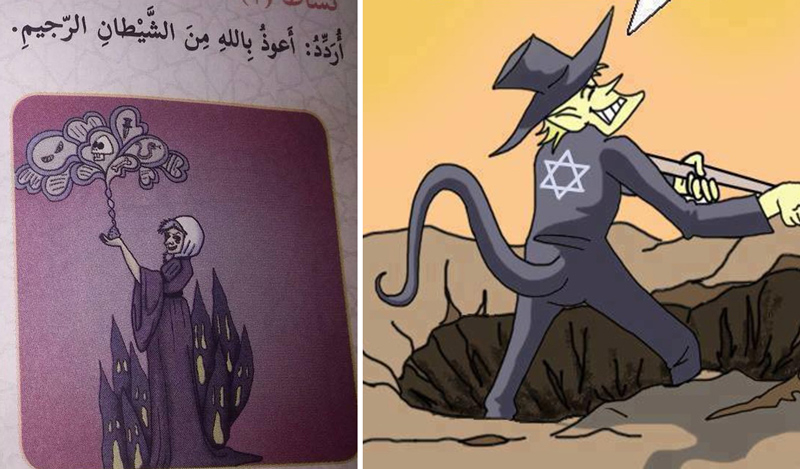
Women as witches is a novel defamation for President Mahmoud Abbas and his crew. Yet Palestinian Authority defamation of others, including Israel, is far from new. Left: A depiction of a witch, from a new Palestinian Authority school textbook. Right: A depiction of a Jew as a demon, from a 2013 posting on the Fatah Facebook page. |
Women as witches is disturbing indeed. Perhaps most disturbing of all, however, is the continued Palestinian blindness to the fact that demonizing others is a deadly boomerang that will turn — and already is turning — back to cut off its very own head.
Khaled Abu Toameh, an award-winning journalist, is based in Jerusalem.








